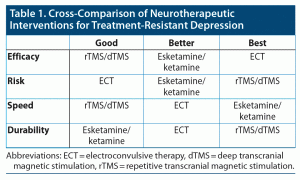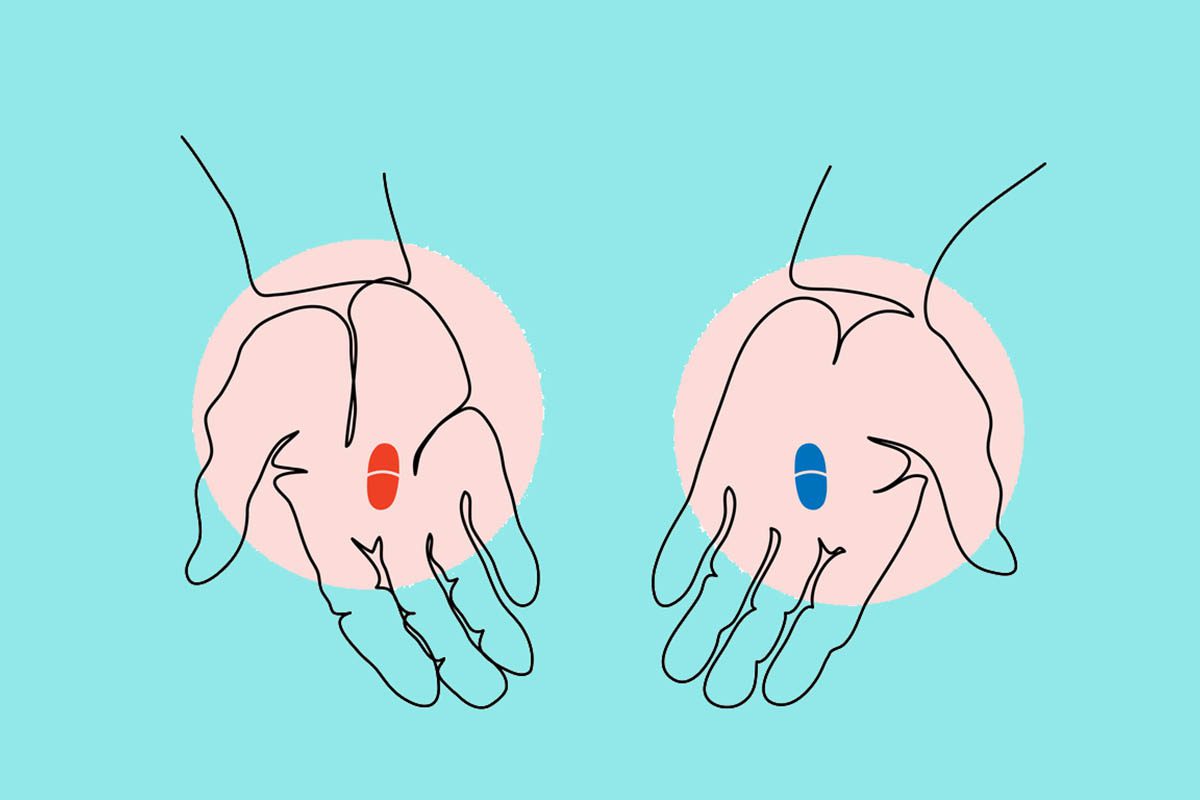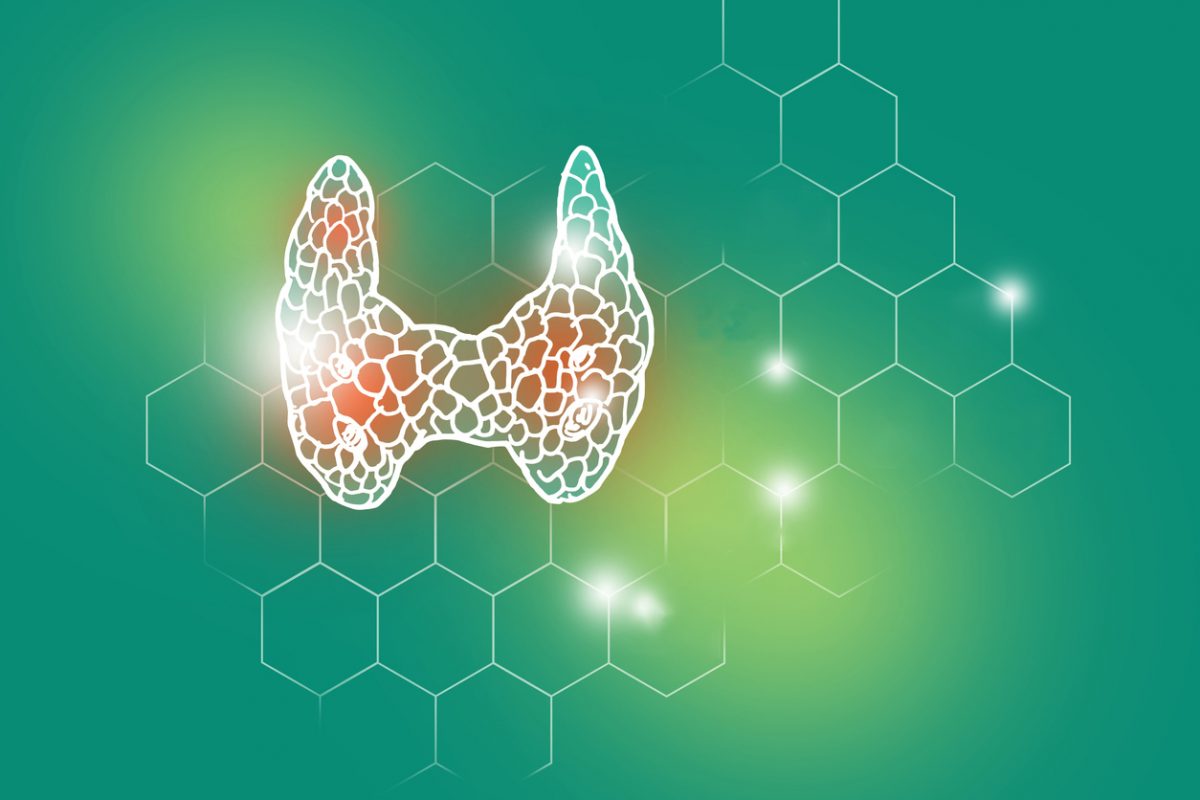
J Clin Psychiatry 2022;83(3):22ac14436
To cite: Berman J, Ambrose AJ. Prioritizing patient preferences: a practical guide for tailoring treatment choices in interventional psychiatry. J Clin Psychiatry. 2022;83(3):22ac14436.
To share: https://doi.org/10.4088/JCP.22ac14436
© Copyright 2022 Physicians Postgraduate Press, Inc.
aColumbia University Irving Medical Center, Columbia Psychiatry Faculty Practice, Columbia University Vagelos College of Physicians and Surgeons, New York, New York
*Corresponding author: Joshua Berman, MD, PhD, Columbia Psychiatry, 1790 Broadway, 7th Fl, New York, NY 10019 ([email protected]).
When patients with major depressive disorder experience 2 or more failed antidepressant trials of adequate dosage and duration, the chances of success with further antidepressant trials fall significantly.1 In such circumstances, perhaps after 1 or more brief augmentation trials, interventional treatments—procedures other than psychotherapy or administration of oral medication—are a logical next step.
Three interventional treatments with good evidence for safety and efficacy are transcranial magnetic stimulation (TMS), esketamine/ketamine, and electroconvulsive therapy (ECT). In navigating these options, identifying patient-specific priorities may help clinician and patient set up a treatment plan that reflects reasonable expectations. Many patients initiate any one of these treatments believing it is “their last hope”—almost always an erroneous conclusion that can undermine treatment and must be corrected at the outset; thus, it is useful to agree on a treatment algorithm, which outlines future steps based on the performance of the prior treatment modalities.
TMS, Ketamine, and ECT: Efficacy, Risk, Speed, Durability
TMS. High frequency left dorsolateral prefrontal cortex TMS has shown 50% symptom reduction or better in ~60% of patients.2 Deep TMS using the H1 coil has shown similar efficacy, even in more treatment-resistant populations.3 The Stanford Neuromodulation Therapy (SNT) intensive theta burst protocol has shown higher response rates but only in small trials,4,5 is not FDA approved, and relies on brain imaging techniques not available or scalable for general clinical use.
TMS is the least invasive interventional treatment, with no alteration of consciousness or limitation on activity following treatment. TMS carries a small seizure risk and a very small risk of hearing loss in patients lacking protective earwear.
Conventional TMS is the “slowest” interventional treatment, requiring 5 treatments per week for 6 weeks; antidepressant benefits are generally reported toward the end of treatment.2 While the limited data on SNT show rapid results, other intensive theta burst protocols are not equally rapid.4,5
TMS is likely the most durable of the 3 treatments, with effects persisting as long as 12 months without maintenance and only brief booster series for recurrences.6
ECT. ECT has shown response rates as high as 80%.7 The multisite Prolonging Remission in Depressed Elderly (PRIDE) trial showed a 62% remission rate in geriatric patients.8
As patients undergo a grand mal seizure under brief general anesthesia without intubation, ECT is the most invasive interventional treatment, but rates of serious medical complication are very low. One study found that morbidity and mortality over a month after discharge in hospital patients matched for severity of depression were lower in those receiving ECT than in the comparison group.9
Times to response for ECT vary. Patients may respond within 5 to 6 treatments, but many need a longer course, ranging up to 6 weeks and beyond for complete remission.
Regarding durability, to avoid relapse during the first year after treatment, ECT patients may need to undergo maintenance treatments with ongoing pharmacotherapy.10 This requirement may reflect higher severity and chronicity of illness in patients who receive ECT.
Ketamine. In small trials, IV ketamine has shown rates of response in the range of 60%–70%.11
While less invasive than ECT, ketamine still involves alteration of consciousness and exposure to a drug of abuse. The most serious potential complications from ketamine observed with doses used in surgical or ICU settings or with ketamine abuse generally have not been observed with psychiatric doses or in psychiatric settings.12
The initial appeal of ketamine was the observation of responses within the first few hours after an infusion, making it the most rapid interventional treatment, but many patients may need several treatments before showing a response.13
Ketamine may be the least durable of the interventional treatments. There is often some decrement of response after the induction period and a need for extended maintenance. While some patients stay well for long periods after cessation of maintenance, there are only limited data on long-term outcomes during continued maintenance or after ketamine is stopped.14
The intranasal formulation of esketamine has received FDA approval for treatment-resistant depression in adults and for depressive symptoms in adults with major depressive disorder with acute suicidal ideation or behavior. The use of esketamine nasal spray can result in measurable improvement within hours. In contrast to IV ketamine, esketamine nasal spray was studied in a randomized withdrawal maintenance trial. Continued use of esketamine nasal spray was superior to placebo in preventing relapse in patients receiving oral antidepressant therapy.15 Because esketamine nasal spray is FDA-approved, many health plans will cover this modality, in contrast to IV ketamine.
Conclusion
Table 1 shows a comparison of the three interventions in terms of efficacy, risk, speed, and durability. Of the 3 primary interventional treatments, ECT has the highest demonstrated efficacy, followed by esketamine/ketamine, and then conventional TMS.
For patients concerned most with risks of treatment, TMS would be a first choice, followed by esketamine/ketamine, with ECT further down the list.
For patients most concerned with speed of response, esketamine/ketamine offers the possibility of the fastest response; ECT also offers the possibility of rapid responses, though less rapid than esketamine/ketamine. TMS is generally the least rapid treatment of the three, but newer forms of TMS may eventually compete with ECT and esketamine/ketamine in speed of response.
For patients concerned with durability of response, TMS is likely the most durable, with ECT less durable, unless there is maintenance, and ketamine the least durable, with possible decrement in response even during maintenance.
Ultimately, feasibility may be the most important determinant in treatment selection; many patients are still limited by what insurance will cover, the need for a companion for esketamine/ketamine or outpatient ECT, or the ability to get to daily treatments for TMS. Finally, all 3 treatments are not available in every locality.
Published online: May 4, 2022.
Relevant financial relationships: None.
Funding/support: None.
The ASCP Corner, edited by Leslie L. Citrome, MD, MPH, is a collection of brief peer-reviewed, evidence-based articles, authored by American Society of Clinical Psychopharmacology members, that examine the practice of psychopharmacology through the lens of clinical experience. The information contained herein only represents the opinion of the author(s).

References (15)

- Rush AJ, Trivedi MH, Wisniewski SR, et al. Acute and longer-term outcomes in depressed outpatients requiring one or several treatment steps: a STAR*D report. Am J Psychiatry. 2006;163(11):1905–1917. PubMed CrossRef
- Dunner DL, Aaronson ST, Sackeim HA, et al. A multisite, naturalistic, observational study of transcranial magnetic stimulation for patients with pharmacoresistant major depressive disorder: durability of benefit over a 1-year follow-up period. J Clin Psychiatry. 2014;75(12):1394–1401. PubMed CrossRef
- Levkovitz Y, Isserles M, Padberg F, et al. Efficacy and safety of deep transcranial magnetic stimulation for major depression: a prospective multicenter randomized controlled trial. World Psychiatry. 2015;14(1):64–73. PubMed CrossRef
- Cole EJ, Phillips AL, Bentzley BS, et al. Stanford Neuromodulation Therapy (SNT): a double-blind randomized controlled trial. Am J Psychiatry. 2022;179(2):132–141. PubMed CrossRef
- Weissman CR, Daskalakis ZJ. Accelerated intermittent theta burst stimulation: expediting and enhancing treatment outcomes in treatment-resistant depression. Am J Psychiatry. 2022;179(2):85–87. PubMed CrossRef
- Senova S, Cotovio G, Pascual-Leone A, et al. Durability of antidepressant response to repetitive transcranial magnetic stimulation: systematic review and meta-analysis. Brain Stimul. 2019;12(1):119–128. PubMed CrossRef
- Husain MM, Rush AJ, Fink M, et al. Speed of response and remission in major depressive disorder with acute electroconvulsive therapy (ECT): a Consortium for Research in ECT (CORE) report. J Clin Psychiatry. 2004;65(4):485–491. PubMed CrossRef
- Kellner CH, Husain MM, Knapp RG, et al; CORE/PRIDE Work Group. Right unilateral ultrabrief pulse ECT in geriatric depression: phase 1 of the PRIDE Study. Am J Psychiatry. 2016;173(11):1101–1109. PubMed CrossRef
- Kaster TS, Vigod SN, Gomes T, et al. Risk of serious medical events in patients with depression treated with electroconvulsive therapy: a propensity score-matched, retrospective cohort study. Lancet Psychiatry. 2021;8(8):686–695. PubMed CrossRef
- Jelovac A, Kolshus E, McLoughlin DM. Relapse following successful electroconvulsive therapy for major depression: a meta-analysis. Neuropsychopharmacology. 2013;38(12):2467–2474. PubMed CrossRef
- Katalinic N, Lai R, Somogyi A, et al. Ketamine as a new treatment for depression: a review of its efficacy and adverse effects. Aust N Z J Psychiatry. 2013;47(8):710–727. PubMed CrossRef
- aan het Rot M, Collins KA, Murrough JW, et al. Safety and efficacy of repeated-dose intravenous ketamine for treatment-resistant depression. Biol Psychiatry. 2010;67(2):139–145. PubMed CrossRef
- Ghasemi M, Kazemi MH, Yoosefi A, et al. Rapid antidepressant effects of repeated doses of ketamine compared with electroconvulsive therapy in hospitalized patients with major depressive disorder. Psychiatry Res. 2014;215(2):355–361. PubMed CrossRef
- Sakurai H, Jain F, Foster S, et al. Long-term outcome in outpatients with depression treated with acute and maintenance intravenous ketamine: a retrospective chart review. J Affect Disord. 2020;276:660–666. PubMed CrossRef
- Citrome L, DiBernardo A, Singh J. Appraising esketamine nasal spray for the management of treatment-resistant depression in adults: number needed to treat, number needed to harm, and likelihood to be helped or harmed. J Affect Disord. 2020;271:228–238. PubMed CrossRef
This PDF is free for all visitors!





